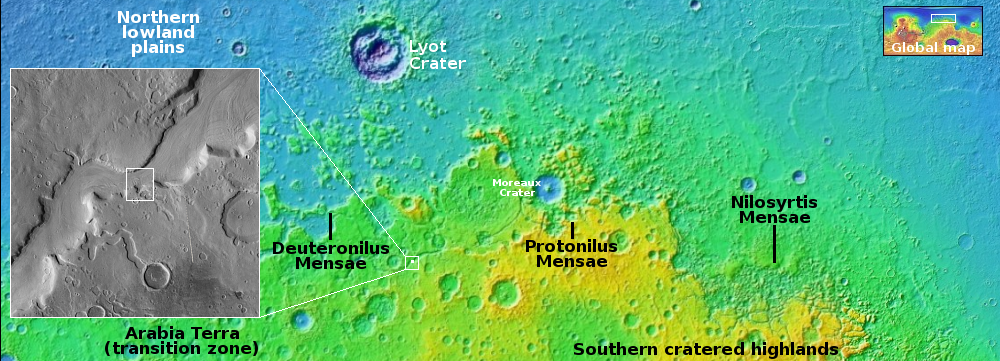Slumping landslide in Mars’ glacier country

Cool image time! The picture to the right, rotated, cropped, reduced, and sharpened to post here, was downloaded on July 1, 2025 from the high resolution camera on Mars Reconnaissance Orbiter (MRO).
Labeled by the science team as a “flow,” it shows what appears to be a major collapse of the canyon’s south wall. The white dot on the overview map above marks the location, near the center of the 2,000-mile-long strip in the northern mid-latitudes of Mars that I label “glacier country” because almost every single high resolution image of this region shows glacial features.
This picture is no exception. First, the canyon appears filled with a glacial material, though its flow direction is unclear. Orbital elevation data suggests that this collapse is actually at the canyon’s high point, with the drainage going downhill to the east and west.
Second, the collapse itself doesn’t look like an avalanche of rocks and bedrock, but resembles more a mudslide. Since liquid water cannot exist in Mars’ thin atmosphere and cold climate, the soft nature of the slide suggests it is dirt and dust impregnated with ice. At some point, either because of the impacts that created the craters on its southern edge or because the sun warmed the ice causing it sublimate away thus weakening the ground structurally, the entire cliff wall slumped downward to the north.
The canyon itself is about 800 feet deep. It likely formed initially along a fault line, with ice acting over time to widen and extend it.
On Christmas Eve 1968 three Americans became the first humans to visit another world. What they did to celebrate was unexpected and profound, and will be remembered throughout all human history. Genesis: the Story of Apollo 8, Robert Zimmerman's classic history of humanity's first journey to another world, tells that story, and it is now available as both an ebook and an audiobook, both with a foreword by Valerie Anders and a new introduction by Robert Zimmerman.
The print edition can be purchased at Amazon or from any other book seller. If you want an autographed copy the price is $60 for the hardback and $45 for the paperback, plus $8 shipping for each. Go here for purchasing details. The ebook is available everywhere for $5.99 (before discount) at amazon, or direct from my ebook publisher, ebookit. If you buy it from ebookit you don't support the big tech companies and the author gets a bigger cut much sooner.
The audiobook is also available at all these vendors, and is also free with a 30-day trial membership to Audible.
"Not simply about one mission, [Genesis] is also the history of America's quest for the moon... Zimmerman has done a masterful job of tying disparate events together into a solid account of one of America's greatest human triumphs."--San Antonio Express-News

Cool image time! The picture to the right, rotated, cropped, reduced, and sharpened to post here, was downloaded on July 1, 2025 from the high resolution camera on Mars Reconnaissance Orbiter (MRO).
Labeled by the science team as a “flow,” it shows what appears to be a major collapse of the canyon’s south wall. The white dot on the overview map above marks the location, near the center of the 2,000-mile-long strip in the northern mid-latitudes of Mars that I label “glacier country” because almost every single high resolution image of this region shows glacial features.
This picture is no exception. First, the canyon appears filled with a glacial material, though its flow direction is unclear. Orbital elevation data suggests that this collapse is actually at the canyon’s high point, with the drainage going downhill to the east and west.
Second, the collapse itself doesn’t look like an avalanche of rocks and bedrock, but resembles more a mudslide. Since liquid water cannot exist in Mars’ thin atmosphere and cold climate, the soft nature of the slide suggests it is dirt and dust impregnated with ice. At some point, either because of the impacts that created the craters on its southern edge or because the sun warmed the ice causing it sublimate away thus weakening the ground structurally, the entire cliff wall slumped downward to the north.
The canyon itself is about 800 feet deep. It likely formed initially along a fault line, with ice acting over time to widen and extend it.
On Christmas Eve 1968 three Americans became the first humans to visit another world. What they did to celebrate was unexpected and profound, and will be remembered throughout all human history. Genesis: the Story of Apollo 8, Robert Zimmerman's classic history of humanity's first journey to another world, tells that story, and it is now available as both an ebook and an audiobook, both with a foreword by Valerie Anders and a new introduction by Robert Zimmerman.
The print edition can be purchased at Amazon or from any other book seller. If you want an autographed copy the price is $60 for the hardback and $45 for the paperback, plus $8 shipping for each. Go here for purchasing details. The ebook is available everywhere for $5.99 (before discount) at amazon, or direct from my ebook publisher, ebookit. If you buy it from ebookit you don't support the big tech companies and the author gets a bigger cut much sooner.
The audiobook is also available at all these vendors, and is also free with a 30-day trial membership to Audible.
"Not simply about one mission, [Genesis] is also the history of America's quest for the moon... Zimmerman has done a masterful job of tying disparate events together into a solid account of one of America's greatest human triumphs."--San Antonio Express-News



The Moon suffers these too it seems
https://phys.org/news/2025-08-apollo-moon-sample-years-evidence.html